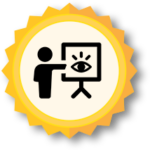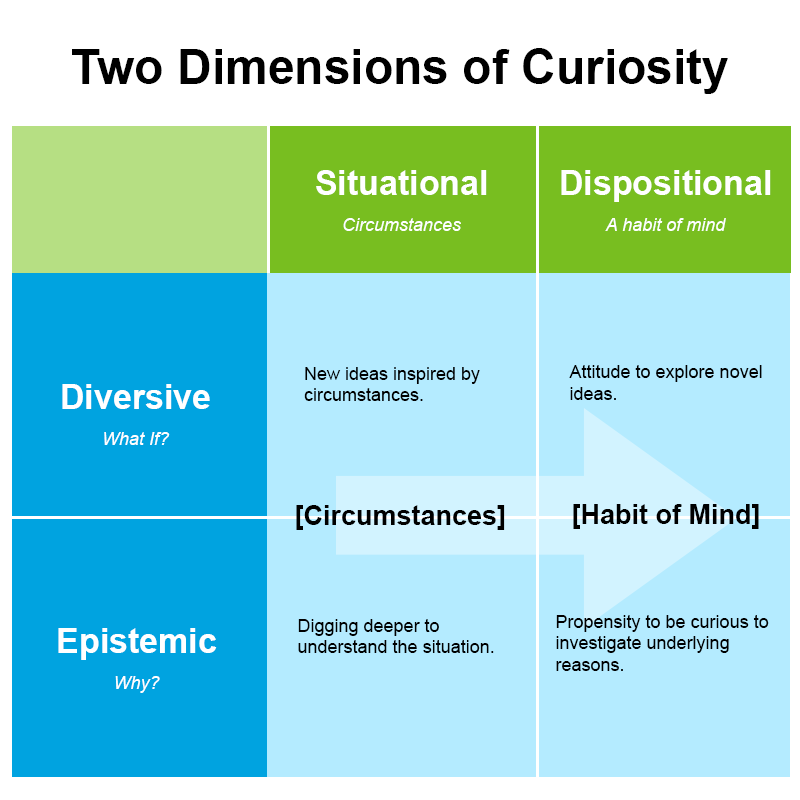Entrepreneurial Mindset Strategy: Curiosity
 Overview and Introduction: The WHAT and WHO
Overview and Introduction: The WHAT and WHO
Being curious means having a strong desire to learn, explore, and discover new things. Curiosity drives us to ask questions, seek out knowledge, and pursue new experiences. Curiosity can manifest in many different ways, such as a desire to understand how things work, a fascination with different cultures or perspectives, or a drive to solve complex problems.
Curiosity is the catalyst of inquiry and leads to solutions. By being curious and exploring contrarian viewpoints for solutions, students can develop an important part of an entrepreneurial mindset. The entrepreneurial mindset (EM) is a problem-solving approach that begins with curiosity about our changing world, connecting information from various resources to gain insight, and identifying unexpected opportunities to create value [1].
Students who are curious will ask [2]:
-
-
- How can we do this differently? Better?
- Why do people think this way?
- What if we tried this approach instead?
-
There are several types of curiosity, including diversive/epistemic [3] and situational/dispositional [4].
-
-
- Diversive curiosity refers to the desire for novelty and variety. Individuals with high levels of diversive curiosity are motivated by the thrill of discovery and the excitement of novel experiences.
- Epistemic curiosity refers to the desire to acquire new knowledge. Individuals with high levels of epistemic curiosity are motivated to explore ideas more deeply to build understanding.
- Situational curiosity refers to the temporary interest in a specific topic. Situational curiosity is typically triggered by a specific circumstance or situation, such as hearing about a new technology.
- Dispositional curiosity refers to the tendency to be curious across a wide range of situations and activities. Individuals with high levels of dispositional curiosity are naturally curious and interested in learning about a variety of topics, even without external incentive. These individuals have cultivated a habit of mind to be curious.
-

Figure 1: Two Dimensions of Curiosity, adapted from A Focus on Curiosity with Tools! [2]

 Implementation and Timing: The WHEN, WHERE, and HOW
Implementation and Timing: The WHEN, WHERE, and HOW
Cultivating curiosity can be done at any time of the semester and across class modalities, although it can be most effective at the beginning of a class or assignment. This early exposure can allow students the time and space to explore that curiosity. A few ideas to implement are below.
Ideas for Implementation
-
-
- Model curiosity and tell a story. Technical content combined with one well-chosen picture or a well-told story can promote a student’s curiosity to investigate more.
- Investigate areas of their own choosing. Allow students some autonomy in an assignment or topic choice. Encourage students to generate their own questions and investigate areas or current trends that they find personally interesting. This can help them develop a sense of ownership over seeking out new knowledge and foster a lifelong desire to learn more. Students can seek out current trends or practice applying course content to real-world examples. For example, if you are teaching about the Internet of Things (IoT), have students choose a new technology in a field of their choice (e.g., healthcare, transportation, agriculture) to explore.
- Curiosity journals. Encourage students to log their thoughts and develop their curiosity habits with prompts that allow them to explore “Why?” and “What if?”
- Encourage interdisciplinary learning. Foster connections between different subjects and disciplines to create a more holistic understanding of complex issues. Encourage students to explore beyond a single subject and investigate areas that pique their interest. This can be done through class discussions, guest speakers, and interdisciplinary projects or programs.
- Consider how to assess. There are scales and assessment tools that faculty can use to assess curiosity in their classroom. The Five-Dimensional Curiosity Scale [5] measures five curiosity dimensions: joyous exploration, deprivation sensitivity, social tolerance, social curiosity, and thrill seeking.
-

 Rationale and Research: The WHY
Rationale and Research: The WHY
For engineers to succeed in a world with rapidly changing needs and tools, they need a sense of curiosity [6]. As mentioned, curiosity is the catalyst of inquiry. Curiosity drives us to ask questions, seek out knowledge, and pursue new experiences. Curiosity is the first step towards developing solutions. Faculty who instill a spirit of curiosity equip students to create extraordinary results [6].

 Additional Resources and References
Additional Resources and References
-
-
- Enhancing student curiosity through exploring chemical reactors by Jean Andino (Dropbox): This assignment requires students to explore the use of chemical reactors in one of four different industries: food generation, paper products production, pollutant control, or pharmaceutical/therapeutics production. Designed for a 400 level course, students engage in background research to explore more and be curious.
- Stress Analysis Lab Assignment by Jay Patel (Dropbox): This assignment is for junior level mechanical/aerospace students to conduct stress analysis on flat plates with varying sized holes subjected to tensile load. Students identify the need of the problem across multiple industries to think critically and recognize opportunity in their recommendations to the airline.
-
Kern Entrepreneurial Engineering Network (KEEN) Cards
-
-
- A More Beautiful Culture: Question-based applications to drive an undergraduate engineering culture toward curiosity by Kurt Paterson (ASU; previously JMU): This card details three simple ways questions have driven a more beautiful culture in JMU’s engineering program.
- Live Virtual Demo in The Class Using Computer Simulation Tools by Brent Sebold, Lindy Mayled, and Saeed Zeinolabedinzadeh (ASU): A virtual demo to inspire curiosity and discussion for graduate students in electrical engineering, but can be applied in other contexts.
- Curiosity: What do we mean? By Doug Melton (Kern Family Foundation): An overview card with several resources and activities to understand curiosity in depth and within an entrepreneurial mindset.
-
Like these resources? See a full list of entrepreneurially minded content here, created by Robust Entrepreneurially Minded Leaders (REMLs) at ASU.
References
[1] ASU KEEN. “ASU KEEN – Kern Entrepreneurship Education Network.” Arizona State University. [Online]. Available: https://entrepreneurship.engineering.asu.edu/asu-keen/
[2] Engineering Unleashed, “Curiosity,” in Engineering Unleashed, Available online: https://engineeringunleashed.com/card/1493
[3] J. A. Litman and C. D. Spielberger, “Measuring epistemic curiosity and its diversive and specific components,” Journal of Personality Assessment, vol. 80, no. 1, pp. 75-86, 2003.
[4] T. B. Kashdan and J. E. Roberts, “Trait and state curiosity in the genesis of intimacy: Differentiation from related constructs,” Journal of Social and Clinical Psychology, vol. 23, no. 6, pp. 792-816, 2004.
[5] T. B. Kashdan, M. C. Stiksma, D. J. Disabato, P. E. McKnight, J. Bekier, J. Kaji, and R. Lazarus, “The five-dimensional curiosity scale: Capturing the bandwidth of curiosity and identifying four unique subgroups of curious people,” Journal of Research in Personality, vol. 73, pp. 130-149, 2018.
[6] Engineering Unleashed. (n.d.). Curiosity. Engineering Unleashed. Retrieved from https://engineeringunleashed.com/curiosity